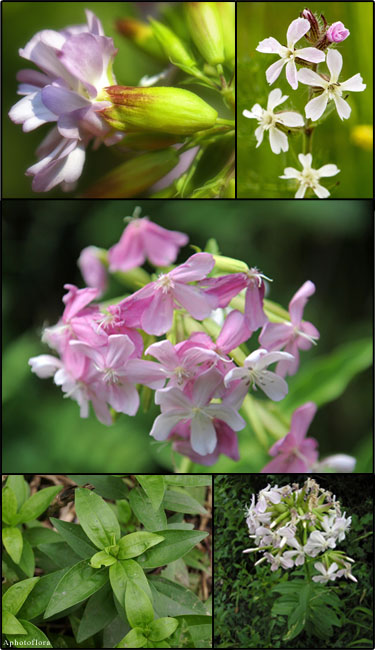Bouncingbet (Saponaria officinalis)
 Synonyms: Lychnis saponaria, Saponaria officinalis L. var. glaberrima
Synonyms: Lychnis saponaria, Saponaria officinalis L. var. glaberrimaCommon Names: Common soapwort, sweet Betty
Description: Seeds are toxic, containing large amounts of saponins, which froth when extracted with water. Leaves contain a natural soap.
Habit: Herbaceous, 1-3 ft tall, grows from rhizomes, short, coarse, almost woody rhizomes.
Leaves: Opposite, elliptic leaves; 3-4 in long and 1/2 to 1-1/2 in wide at the middle, toothed.
Stems: Erect and jointed; unbranched.
Flowers: Clustered, cylindrical sepals, 5-6 petals notched at the apex, white to pink in color; blooms from June through September.
Fruit and seeds: Seed pod, 1 in long and 1/4 in thick containing many somewhat round black seeds. The seeds have minute bumps on the surface.
Habitat: Native to Europe and Asia. Found along roadsides, waste places, open unused areas.
Reproduction: By seed.
Similar species: Cowcockle (Saponaria vaccaria).
Monitoring and rapid response: Hand-pulling for small infestations; use of broadleaf herbicides. Credits: The information provided in this factsheet was gathered from the USDA PLANTS Database.
Individual species images that appear with a number in a black box are courtesy of the Bugwood.org network (http://www.invasive.org).Individual photo author credits may not be included due to the small display size of the images and subsequent difficulty of reading the provided text. All other images appear courtesy of Google (https://images.google.com).
Common Name: | Bouncingbet |
Scientific Name: | Saponaria officinalis |
Family: | Caryophyllaceae (Pink) |
Duration: | Perennial |
Habit: | Herbs |
USDA Symbol: | SAOF4 |
